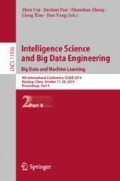Abstract
The brain functional connectivity network (BFCN) based methods for diagnosing brain diseases have shown great advantages. At present, most BFCN construction strategies only calculate the first-order correlation between brain areas, such as the Pearson correlation coefficient method. Although the work of the low-order and high-order BFCN construction methods exists, there is very little work to integrate them, that is, to design a multi-modal BFCN feature selection and classification method to combine low-order and high-order information. This may affect the performance of brain disease diagnosis. To this end, we propose a multi-modality low-rank learning framework jointly learning first-order and second-order BFCN information and apply it to the diagnosis of schizophrenia. The proposed method not only embeds the correlation information of multi-modality data in the learning model, but also encourages the cooperation between the first-order and the second-order BFCN by combining the ideal representation term. The experimental results of the three schizophrenia datasets (totally including 168 patients and 163 normal controls) show that our proposed method achieves promising classification results in the diagnosis of schizophrenia.
Access this chapter
Tax calculation will be finalised at checkout
Purchases are for personal use only
References
Bluhm, R.L., et al.: Spontaneous low-frequency fluctuations in the BOLD signal in schizophrenic patients: anomalies in the default network. Schizophr. Bull. 33, 1004–1012 (2007)
Richiardi, J., Achard, S., Bunke, H., Van De Ville, D.: Machine learning with brain graphs: predictive modeling approaches for functional imaging in systems neuroscience. IEEE Signal Process. Mag. 30, 58–70 (2013). https://doi.org/10.1109/MSP.2012.2233865
Guo, S., Kendrick, K.M., Yu, R., Wang, H.L.S., Feng, J.: Key functional circuitry altered in schizophrenia involves parietal regions associated with sense of self. Hum. Brain Mapp. 35, 123–139 (2014). https://doi.org/10.1002/hbm.22162
Zhu, Q., Li, H., Huang, J., Xu, X., Guan, D., Zhang, D.: Hybrid functional brain network with first-order and second-order information for computer-aided diagnosis of schizophrenia. Front. Neurosci. 13, 603 (2019). https://doi.org/10.3389/fnins.2019.00603
Huang, S., et al.: Identifying Alzheimer’s disease-related brain areas from multi-modality neuroimaging data using sparse composite linear discrimination analysis. In: Advances in Neural Information Processing Systems, vol. 1431–1439 (2011)
Zhang, D., Shen, D.: Multi-modal multi-task learning for joint prediction of multiple regression and classification variables in Alzheimer’s disease. Neuroimage 59, 895–907 (2012). https://doi.org/10.1016/j.neuroimage.2011.09.069
Candès, E.J., Tao, T.: The power of convex relaxation: near-optimal matrix completion. IEEE Trans. Inf. Theory 56, 2053–2080 (2010)
Zhu, Q., Li, H., Huang, J., Xu, X., Guan, D., Zhang, D.: Hybrid functional brain network with first-order and second-order information for computer-aided diagnosis of schizophrenia. Front. Neurosci. 13, 603 (2019). https://doi.org/10.3389/fnins.2019.00603
Liu, G., Lin, Z., Yan, S., Sun, J., Yu, Y., Ma, Y.: Robust recovery of subspace structures by low-rank representation. IEEE Trans. Pattern Anal. Mach. Intell. 35, 171–184 (2013). https://doi.org/10.1109/TPAMI.2012.88
Zhang, N., Yang, J.: Low-rank representation based discriminative projection for robust feature extraction. Neurocomputing 111, 13–20 (2013). https://doi.org/10.1016/j.neucom.2012.12.012
Candès, E.J., Recht, B.: Exact matrix completion via convex optimization. Found. Comput. Math. 9, 717–772 (2009). https://doi.org/10.1007/s10208-009-9045-5
Fazel, M.: Matrix Rank Minimization with Applications. Dissertation (2002)
Jie, B., Zhang, D., Cheng, B., Shen, D.: Manifold regularized multitask feature learning for multimodality disease classification. Hum. Brain Mapp. 36, 489–507 (2015)
Liu, G., Lin, Z., Yan, S., Sun, J., Yu, Y., Ma, Y.: Robust recovery of subspace structures by low-rank representation. IEEE Trans. Pattern Anal. Mach. Intell. 35, 171–184 (2013). https://doi.org/10.1109/TPAMI.2012.88
Wright, J., Ganesh, A., Rao, S., Ma, Y.: Robust principal component analysis: exact recovery of corrupted low-rank matrices, vol. 1, pp. 289–298 (2009). 58
Zhu, C., Wei, L., Zhou, R., Wang, X., Wu, A.: Robust subspace segmentation by self-representation constrained low-rank representation. In: Neural Processing Letters, pp. 1671–1691 (2018) https://doi.org/10.1007/s11063-018-9783-y
Lin, Z., Chen, M., Wu, L., Ma, Y.: The Augmented Lagrange Multiplier Method for Exact Recovery of Corrupted Low-Rank Matrices. Eprint Arxiv. 9 (2010)
Zhang, Z., Liu, L., Shen, F., Shen, H.T., Shao, L.: Binary multi-view clustering. IEEE Trans. Pattern Anal. Mach. Intell. 41, 1 (2018)
Yang, J., Yin, W., Zhang, Y., Wang, Y.: A fast algorithm for edge-preserving variational multichannel image restoration. SIAM J. Imaging Sci. 2, 569–592 (2009)
Zhang, X., Jia, Y.: A linear discriminant analysis framework based on random subspace for face recognition. Pattern Recogn. 40, 2585–2591 (2007). https://doi.org/10.1016/j.patcog.2006.12.002
Chang, C., Lin, C.: LIBSVM. ACM Trans. Intell. Syst. Technol. 2, 1–27 (2011). https://doi.org/10.1145/1961189.1961199
Cai, D., He, X., Han, J.: Speed up kernel discriminant analysis. VLDB J. 20, 21–33 (2011)
Zhang, D., Wang, Y., Zhou, L., Yuan, H., Shen, D.: Multimodal classification of Alzheimer’s disease and mild cognitive impairment. Neuroimage 55, 856–867 (2011). https://doi.org/10.1016/j.neuroimage.2011.01.008
Foroughi, H., Shakeri, M., Ray, N., Zhang, H.: Face recognition using multi-modal low-rank dictionary learning. In: 2017 IEEE International Conference on Image Processing (ICIP), pp. 1082–1086. IEEE (2017). https://doi.org/10.1109/ICIP.2017.8296448
Acknowledgments
This work was supported in part by National Natural Science Foundation of China (Nos. 61501230, 61732006, 61876082 and 81771444), National Science and Technology Major Project (No. 2018ZX10201002), and the Fundamental Research Funds for the Central Universities (No. NJ2019010).
Author information
Authors and Affiliations
Corresponding author
Editor information
Editors and Affiliations
Rights and permissions
Copyright information
© 2019 Springer Nature Switzerland AG
About this paper
Cite this paper
Li, H., Zhu, Q., Zhang, R., Zhang, D. (2019). Multi-modality Low-Rank Learning Fused First-Order and Second-Order Information for Computer-Aided Diagnosis of Schizophrenia. In: Cui, Z., Pan, J., Zhang, S., Xiao, L., Yang, J. (eds) Intelligence Science and Big Data Engineering. Big Data and Machine Learning. IScIDE 2019. Lecture Notes in Computer Science(), vol 11936. Springer, Cham. https://doi.org/10.1007/978-3-030-36204-1_30
Download citation
DOI: https://doi.org/10.1007/978-3-030-36204-1_30
Published:
Publisher Name: Springer, Cham
Print ISBN: 978-3-030-36203-4
Online ISBN: 978-3-030-36204-1
eBook Packages: Computer ScienceComputer Science (R0)

